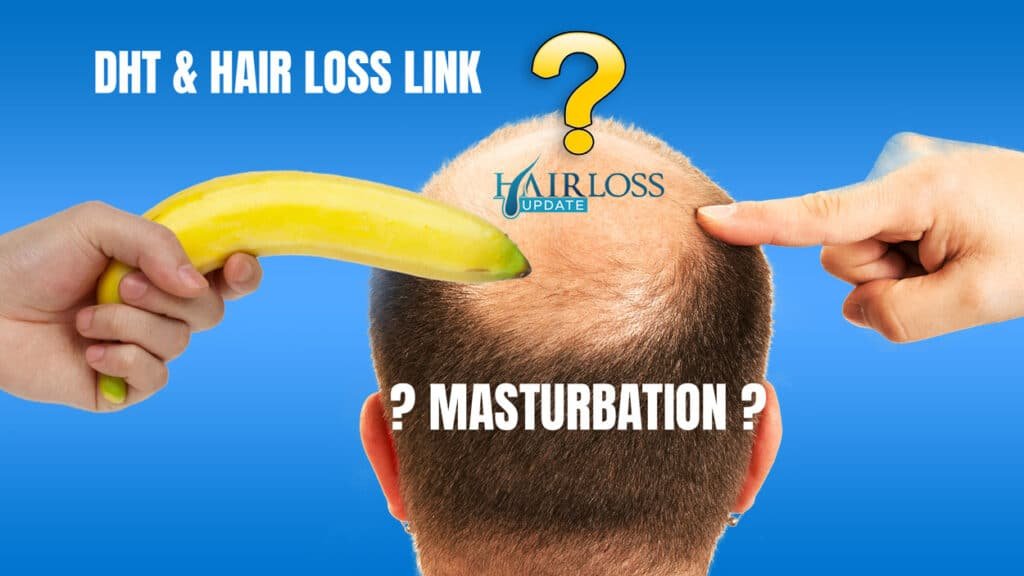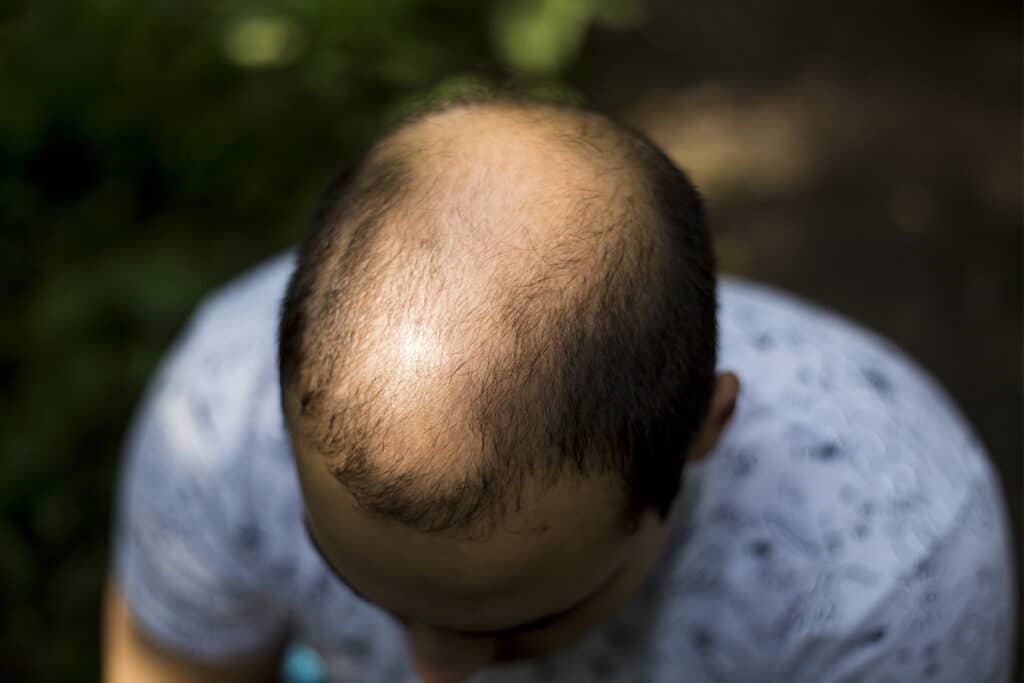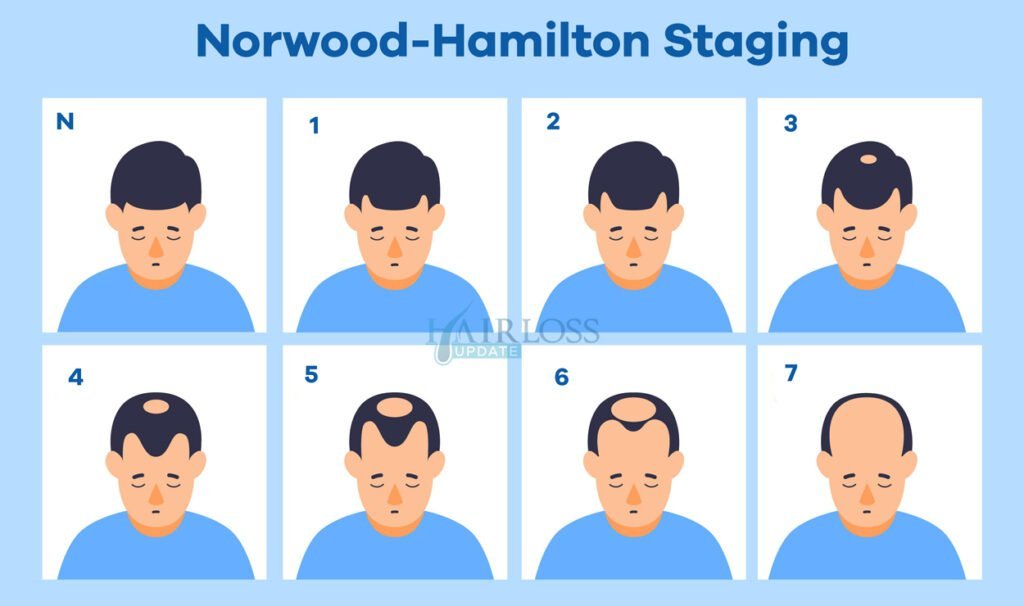Contents
Discover the Alopecia DHT link, a hormone derived from testosterone, and its role in hair loss, including androgenetic alopecia (male pattern baldness).
Did you know that about 50 million males and 30 million females in the U.S. deal with hair loss? Androgenetic alopecia, or pattern hair loss, is a condition that starts early and gets worse over time. It affects up to half of all men over 50 in the U.S. This condition makes hair fall out in a specific pattern in both men and women. But what makes this hair loss happen?
The key is a strong hormone called dihydrotestosterone (DHT). It’s the strongest of the androgens and can’t turn into estrogen. DHT comes from testosterone with the help of an enzyme called 5-alpha reductase. It’s mainly made in the body’s tissues and works as a hormone that affects nearby cells. High levels of DHT, 5-alpha reductase, and androgen receptors in the scalp shrink hair follicles. This leads to the thinning and loss of hair seen in androgenetic alopecia.
DHT is key in causing androgenetic alopecia. It binds to androgen receptors twice as well as testosterone and doesn’t let go easily. When there’s more DHT in hair follicles, hair grows for a shorter time and becomes thinner. This is called miniaturization, a main sign of DHT-related hair loss.
Even though DHT helps grow body, facial, and pubic hair, too much of it can cause hair loss. It overstimulates hair follicles, making them shrink and produce less hair. Knowing how DHT and alopecia are linked helps us find better treatments and ways to manage this common issue.

Key Points Discussed:
- Androgenetic alopecia affects up to 50 million males and 30 million females in the United States.
- DHT is a potent androgen converted from testosterone by the enzyme 5-alpha reductase.
- Increased levels of DHT, 5-alpha reductase, and androgen receptors in the scalp contribute to hair follicle miniaturization.
- DHT has a higher binding affinity to androgen receptors compared to testosterone, leading to shorter hair growth cycles.
- Excessive DHT levels can overstimulate hair follicles, causing them to shrink and produce thinner hair strands.
Understanding DHT and Its Effects on Hair
To understand how hair loss relates to dihydrotestosterone (DHT), we need to know what DHT is and its impact on hair growth. DHT comes from testosterone, the main male hormone. About 10% of testosterone turns into DHT daily in adults, thanks to an enzyme called 5-alpha reductase.
What is DHT?
DHT is stronger than testosterone and binds better to receptors in the body. It’s important for male growth during puberty but can cause health problems if levels get too high. Studies show high DHT levels are linked to bigger prostate, prostate cancer, and polycystic ovary syndrome. People born male have more DHT because they make more testosterone.
The Role of 5-Alpha Reductase in Converting Testosterone to DHT
The enzyme 5-alpha reductase turns testosterone into DHT. There are two types: Type 1 and Type 2. Type 2 is mainly in hair follicles and makes most DHT in the scalp. People prone to hair loss often have more Type 2 5-alpha reductase, making more DHT.
Does Masturbation Cause Hair Loss?
This is still a controversial topic. But I will just tell you some scientific facts and things that happen in your body and you decide for yourself. When you masturbate or ejaculate, the Testosterone levels rise and DHT formation also should rise due to the availability of lots of testosterone. One fact to remember is: that this might increase DHT but again, this action may be important for genetically predisposed individuals, and not everyone will go bald. I think genetically predisposed people should be careful about this and hold on till enough scientific data on this is available. You must also know that anything in excess is BAD!
DHT’s Impact on Hair Follicles and Hair Growth Cycle
High DHT levels can mess with the hair growth cycle. It shortens the growth phase and lengthens the resting phase. This makes hair follicles produce smaller, thinner hair. Eventually, some follicles stop making hair, leading to more hair loss.

DHT’s effect on hair is clear in androgenetic alopecia, a common type of hair loss linked to more DHT in the scalp3.
While DHT is a big factor in hair loss, other things can also cause it. This includes autoimmune diseases, thyroid issues, celiac disease, and scalp infections4. Knowing the cause of hair loss helps pick the best treatment.
Androgenetic Alopecia: The Most Common Form of Hair Loss
Androgenetic alopecia, also known as pattern hair loss, is the most common type of hair loss. It affects millions of men and women worldwide. In the United States, it affects about 50 million men and 30 million women. This type of hair loss is marked by a gradual thinning of hair on the scalp, often in a predictable pattern.
Male Pattern Baldness
In men, this type of hair loss is known as male pattern baldness. It often shows as a receding hairline and thinning on the crown. By age 50, about 50% of Caucasian males suffer from it. By age 70, this number jumps to around 80%. Male androgenetic alopecia affects 30-50% of men by age 50. Over 50% of men over 50 experience some hair loss.

Female Pattern Hair Loss
Women with this condition see a thinning of hair on the crown, keeping the frontal hairline intact. This is known as female pattern hair loss. It affects up to 50% of women. Women often see a rise in hair loss after menopause. Hair loss is most common during this life stage.
Genetics and Hereditary Factors in Androgenetic Alopecia
Genetics greatly affects androgenetic alopecia, with hereditary playing a big part. About 80% of the risk comes from genes. Sons of balding fathers face a 5 to 6 times higher risk of getting it6. Research shows genes like the AR gene are involved. Other genes are also thought to play a part. These genetic changes raise the risk of hair loss in both men and women with this condition.
| Age Group | Prevalence in Men | Prevalence in Women |
|---|---|---|
| Teens | Can start as early as this age | Rare |
| 40-49 years | 53% (moderate to severe MAA in the USA) | Gradually increases |
| 50 years | 30-50%, 50% in Caucasian males | Notably rises after menopause |
| 70 years | 80% in Caucasian males | Continues to increase |
Pattern alopecia often starts after puberty. It can even begin in the teens. As people get older, more people get this condition. The number of affected men goes from 31% (age 40-55) to 53% (age 65-69) for vertex or full baldness7.
The Hair Growth Cycle and DHT’s Influence
The hair growth cycle has three main phases: anagen, catagen, and telogen. Knowing how these phases work and DHT’s role is key to treating hair loss.
Anagen (Growth) Phase
The anagen phase is when hair grows actively, lasting two to six years. It’s when the hair follicle makes new hair fibers, making hair longer and thicker. About 80-90% of scalp hairs are in this phase.
DHT can shorten the anagen phase, making hair shorter and finer. This is known as miniaturization, a sign of androgenetic alopecia.
Catagen (Transition) Phase
The catagen phase is a short transition after anagen, lasting weeks. It’s when the hair follicle shrinks and growth slows. The hair detaches from blood supply and becomes fully keratinized.
DHT’s effect on catagen isn’t fully understood. But, it might prolong this phase, making hair thinner.
Telogen (Resting) Phase
The telogen phase is the resting phase, lasting months to a year. No new hair growth happens here. About 10-20% of scalp hairs are resting.
DHT can keep hair follicles resting longer. This, with shorter anagen phases, reduces hair density and thickness over time.
Androgen receptors activated by DHT lead to smaller hair follicles. This makes hair finer and shorter with each cycle. Eventually, follicles can’t produce new hair, causing baldness9.
Medicines like finasteride and dutasteride lower DHT at the scalp. They help manage hair health and slow down or reverse baldness.
Miniaturization of Hair Follicles Due to DHT
Androgenetic alopecia, the most common hair loss type, leads to miniaturized hair follicles. High DHT levels cause these follicles to shrink, leading to thinner hair. This results in hair thinning and loss, especially in the temples and mid-frontal scalp.

DHT’s effect on androgen receptors causes hair follicle miniaturization. Balding areas have more androgen receptors than non-balding areas. This leads to fine, vellus-like hair and eventually, visible hair loss.
Approximately 80% of predisposition to male androgenetic alopecia is due to heredity.
Factors like age, race, and genetics affect how severe hair follicle miniaturization is. For example:
- Caucasians are more likely to experience severe male androgenetic alopecia.
- Japanese men start losing hair about a decade later than Caucasians.
- Black, Oriental, Native American, and African-American men tend to have less extensive and late-onset baldness than Caucasians.
Reducing DHT levels with finasteride and dutasteride can slow hair loss and promote growth. Finasteride reduces scalp and serum DHT by 64% and 68%, respectively. Yet, these treatments don’t stop hair loss completely, just slow it down.
| Age Group | Prevalence of Male Androgenetic Alopecia |
|---|---|
| By age 50 | 30-50% of men |
| 17-26 years (Singaporean males) | 32% |
| 40-49 years (USA survey) | 53% (moderate or severe) |
| After 80 years | 100%7 |
Understanding hair follicle miniaturization and its link to DHT is key for those with hair loss. Exploring treatments and lifestyle changes to manage DHT can help slow down androgenetic alopecia. This can lead to healthier, fuller-looking hair.
Diagnosing Androgenetic Alopecia
Diagnosing androgenetic alopecia starts with a detailed physical check-up. Dermatologists at NYU Langone look closely at hair loss patterns and use computer tools to confirm their findings. They also ask about your health history, family hair loss, and lifestyle to understand your situation better.

Tests like the Pull Test and Tug Test check how severe hair loss is. If you lose six or more strands, it shows you’re losing hair. Trichometric analysis lets doctors zoom in on scalp images up to 100 times, helping them see hair and follicles closely.
Physical Examination and Patterns of Hair Loss
Your dermatologist will look closely at how you’re losing hair during the exam. Male pattern baldness affects many people, getting more common with age. White people and Afro-Caribbean individuals are more likely to experience it, while Chinese and Japanese folks are less likely. Native American, First Nations, and Alaska Native peoples rarely see male pattern baldness.
Female pattern hair loss is also common, with 12% of women losing hair by age 30 and 30% to 40% by age 60 to 69. Losing 100-150 hairs a day while showering is normal.
Norwood-Hamilton Scale for Male Pattern Baldness
The Norwood-Hamilton scale classifies male pattern baldness from minor to severe. It helps doctors see how bad hair loss is and plan treatment.

| Norwood-Hamilton Stage | Description |
|---|---|
| Stage 1 | Minimal hairline recession |
| Stage 2 | Triangular, usually symmetrical areas of recession at the frontotemporal hairline |
| Stage 3 | Deep symmetrical recession at the temples that are bare or only sparsely covered by hair |
| Stage 4 | Frontal and frontotemporal recession with diffuse thinning over the vertex |
| Stage 5 | Vertex hair loss region is separate from the frontal region and sparsely covered by hair or bare |
| Stage 6 | Frontal and vertex hair loss regions are combined with a significant amount of hair loss |
| Stage 7 | Only a narrow band of hair in a horseshoe shape survives on the sides and back of the scalp |
Ludwig Scale for Female Pattern Hair Loss
The Ludwig scale looks at the degree of thinning over the crown in women. It helps doctors see how bad hair loss is and plan treatment.
| Ludwig Stage | Description |
|---|---|
| Stage 1 | Minimal thinning that can be camouflaged with hair styling techniques |
| Stage 2 | Decreased volume and noticeable widening of the midline part |
| Stage 3 | Diffuse thinning, with a see-through appearance on the top of the scalp |
Sometimes, blood tests are needed if there’s a chance of iron deficiency, thyroid disease, or too much androgen. Low iron can cause hair loss, especially in women who menstruate or eat mostly plants. Thyroid issues, like too much or too little thyroid hormone, can also lead to hair loss, and tests check for this. Too much androgen in women can cause hair loss without bald spots.
Photographs are key to track how well treatments work, comparing before and after shots. By using exams, scales, and tests, doctors can accurately diagnose androgenetic alopecia. They can then create a treatment plan just for you.
Treatments for DHT-Related Hair Loss
There are many ways to treat DHT-related hair loss. DHT makes hair follicles shrink, leading to thinner and finer hair. To fight this, DHT blockers have been developed. These treatments can slow down hair loss and may even help hair grow back.

Finasteride: A 5-Alpha Reductase Inhibitor
Finasteride (Propecia) is a drug for men that can make hair grow back in some cases. It may cause a decrease in sex drive and increase the risk of prostate cancer. By blocking the conversion of testosterone to DHT, it slows down hair loss and helps hair grow back. DHT blockers can show results in a few months to a year, making hair thicker and more voluminous.
Minoxidil: A Topical Vasodilator
Minoxidil (Rogaine) is a medication for hereditary baldness that you can buy over the counter. It needs to be used for at least six months to stop hair loss and regrow hair. Applied directly to the scalp, it increases blood flow and helps hair grow. It comes in different strengths, making it easy to find the right one for your hair loss.
Hair Transplantation and Surgical Options
For severe hair loss, hair transplantation surgery is an option. This surgery moves hair follicles from one part of the head to a bald area. It can cause bleeding, bruising, swelling, and infection. While it offers a lasting solution, remember that insurance usually doesn’t cover it.
DHT blockers don’t cure hair loss forever but can slow it down. You can find both pharmaceutical and natural DHT blockers. Other treatments include spironolactone (Carospir, Aldactone) and oral dutasteride (Avodart). Laser therapy is also approved for hereditary hair loss, improving hair density, but more studies are needed for long-term effects.
Lifestyle Changes and Natural Remedies for Managing DHT Levels
Medical treatments like finasteride and minoxidil help with hair loss due to DHT. But, making lifestyle changes and using natural remedies can also help. These changes can support your hair’s growth and keep your scalp healthy.
Diet and Nutrition
Eating well is key for healthy hair and managing DHT. Foods rich in vitamin B6, zinc, and saw palmetto can help. Zinc is important for hair health and thyroid function. Studies show that zinc levels affect hair loss.
Adding soy protein to your meals can also lower DHT levels. A study found that soy protein was better than milk protein in reducing DHT. Men eating soy protein saw lower DHT levels than those eating milk protein.
Stress Management
Stress can make hair loss worse by affecting the hair growth cycle and causing scalp inflammation. Using stress-reducing activities like meditation and exercise can help. These practices can lower stress and keep your scalp healthy.
Herbal Supplements and Their Efficacy
Some herbal supplements may help with DHT levels and hair growth. Green tea has compounds that stop DHT production and help hair grow. Quercetin in onions can stop testosterone from turning into DHT, which is good for hair.
Herbs like saw palmetto, pumpkin seed oil, and pygeum might also help by blocking an enzyme that makes DHT. But, we need more studies to know how well they work and how much to take.
| Herbal Supplement | Potential Benefits |
|---|---|
| Green Tea Extract | Contains catechins that inhibit DHT production |
| Saw Palmetto | May block 5-alpha reductase activity |
| Pumpkin Seed Oil | Potentially reduces DHT levels in the scalp |
| Pygeum | May inhibit 5-alpha reductase enzyme |
Changing your lifestyle, eating well, managing stress, and using herbal supplements can help with DHT levels and hair growth. But, talk to a doctor before starting any supplements to make sure they’re safe for you.
Alopecia DHT Link: The Connection Between Androgenetic Alopecia and DHT
The link between alopecia and DHT is clear. DHT is key in causing androgenetic alopecia, the most common hair loss type. About 50% of men over 50 and 50% of women over 65 suffer from this type of hair loss19. The NIH says 50 million men and 30 million women in the U.S. deal with androgenetic alopecia.
DHT is a strong androgen made from testosterone. It sticks to hair follicle receptors better than testosterone. This leads to smaller hair follicles, shorter hair, and more hair loss.
Studies in the 1970s found that men without DHT didn’t go bald21. Genetics and how sensitive you are to DHT also play a part in hair loss. Androgenetic alopecia often runs in families, showing it might be genetic.
Male pattern hair loss affects 80 to 90% of men, and 40% of women by 50. Women can lose hair due to androgenetic alopecia, even with lower testosterone levels than men. Female hair loss is more complex and not fully understood.
DHT is much stronger than testosterone and is used mainly in the prostate, skin, and hair follicles. The link between DHT and hair loss is strong, with 12 companies working on new balding treatments.
There’s no cure for androgenetic alopecia, but treatments like finasteride and minoxidil can slow it down. Finasteride (Propecia) stops testosterone from turning into DHT and treats male baldness. Dutasteride (Avodart) might also help with male pattern baldness.
In summary, DHT’s role in androgenetic alopecia is clear. Knowing how DHT affects hair loss helps in finding treatments and managing this common issue.
Future Research and Potential Treatments
The hair transplant market is set to hit €24 billion ($28 billion) by 2027, showing a big demand for hair loss solutions. Currently, minoxidil and finasteride are top treatments for hair loss. But, new studies and therapies could bring more options.
Ongoing Studies on DHT and Hair Loss
Scientists are looking into how DHT affects hair follicles. They want to find new ways to treat hair loss. Studies in Asia have found unique patterns of hair loss, helping to guide new treatments.
They’ve also found genes linked to hair loss. This shows how some people are more likely to lose hair. Researchers are studying how inflammation and stress affect hair growth in people with hair loss.
Emerging Therapies and Their Potential
New treatments like JAK inhibitors are being approved for hair loss. In tests, 23% of people grew more hair after six months of treatment.
Companies are working on new hair loss treatments. They’re looking at new ways to help patients. Breezula is a new treatment with few side effects, which is good news.
Other new treatments include PRP, LLLT, and stem cell therapy. These methods aim to grow hair by fighting DHT’s effects. A study on using stem cells showed promising results for treating hair loss.
Many studies have looked at different treatments like minoxidil, finasteride, and more. They’ve found what works best for hair loss in both men and women.
As we learn more about DHT, genetics, and hair loss, new treatments could come. This could help people with hair loss.
Conclusion
The link between alopecia and DHT is key to understanding androgenetic alopecia, a common hair loss issue. By age 50, about half of men and a quarter of women face this problem. Studies show that certain genes, like the 5alpha-reductase genes, are linked to this type of hair loss.
DHT is made from testosterone and affects hair follicles, making hair smaller and lighter. To fight DHT-related hair loss, treatments like finasteride and minoxidil are available. Hair transplantation is another option. Eating well, managing stress, and trying herbal supplements can also help keep hair healthy.
Research is ongoing to better understand how genetics, hormones, and hair loss are connected. New treatments and therapies are being developed for androgenetic alopecia. By learning about the DHT link and trying different treatments, people can manage their hair loss and feel better overall.
FAQ
What is DHT, and how does it affect hair loss?
DHT is a strong form of androgen made from testosterone. It sticks to receptors in hair follicles, causing them to shrink and grow hair less. This makes hair thinner, shorter, and lighter, leading to more hair loss, especially if you’re prone to it.
What is the role of 5-alpha reductase in the production of DHT?
5-alpha reductase is an enzyme that turns testosterone into DHT. It’s mainly found in the scalp’s outer root sheath. By blocking this enzyme, drugs like finasteride can lower DHT levels and slow hair loss.
Androgenetic alopecia, or pattern hair loss, is the most common hair loss type. It shows up as hair thinning in a specific pattern. This is due to DHT making hair follicles smaller. Your genes affect how much DHT affects your hair follicles.
How does DHT affect the hair growth cycle?
DHT shortens the growth phase of hair and lengthens the resting phase. This makes hair shorter, thinner, and lighter. With repeated DHT exposure, hair follicles keep shrinking, causing more hair loss and bald spots.
For DHT-related hair loss, you can try finasteride or minoxidil. Finasteride blocks DHT production, and minoxidil helps hair grow. For severe cases, hair transplant surgery can help restore hair in bald spots.
Can lifestyle changes and natural remedies help manage DHT levels and support healthy hair growth?
Yes, changing your lifestyle and using natural remedies can help. Eating foods rich in proteins, vitamins, and minerals is good for your hair. Stress reduction and supplements like saw palmetto and green tea might also help control DHT, but more studies are needed.
What is the link between androgenetic alopecia and DHT?
Androgenetic alopecia and DHT are closely linked. DHT attaches to hair follicle receptors more than testosterone, causing them to shrink. Your genes and how your body reacts to DHT can make you more likely to get this type of hair loss.
Researchers are working on new treatments for DHT-related hair loss. They’re looking into how DHT affects hair follicles and exploring therapies like PRP, LLLT, and stem cell treatments. As research goes on, we might see new and better treatments soon.
Source Links
- Biochemistry, Dihydrotestosterone – StatPearls – NCBI Bookshelf – https://www.ncbi.nlm.nih.gov/books/NBK557634/
- DHT (Dihydrotestosterone): What It Is, Side Effects & Levels – https://my.clevelandclinic.org/health/articles/24555-dht-dihydrotestosterone
- Androgenetic alopecia: MedlinePlus Genetics – https://medlineplus.gov/genetics/condition/androgenetic-alopecia/
- Androgenetic Alopecia – StatPearls – NCBI Bookshelf – https://www.ncbi.nlm.nih.gov/books/NBK430924/
- Male Androgenetic Alopecia – Endotext – https://www.ncbi.nlm.nih.gov/books/NBK278957/
- Connection Between Testosterone, DHT and Hair Loss – ISHRS – https://ishrs.org/dht-blockers-hair-loss/
- Cause of Androgenic Alopecia: Crux of the Matter – https://www.ncbi.nlm.nih.gov/pmc/articles/PMC4174066/
- Hair loss – Diagnosis and treatment – Mayo Clinic – https://www.mayoclinic.org/diseases-conditions/hair-loss/diagnosis-treatment/drc-20372932
- Influence of Nutrition, Food Supplements and Lifestyle in Hair Disorders – https://www.ncbi.nlm.nih.gov/pmc/articles/PMC9650738/
- Androgenetic Alopecia (Pattern Hair Loss) – https://www.alopecia.org.uk/androgenetic-alopecia-pattern-hair-loss
- Could we see a new dawn for hair loss treatments? – https://www.labiotech.eu/in-depth/hair-loss-drugs-innovation/
- Cell Therapy for Androgenetic Alopecia: Elixir or Trick? – https://www.ncbi.nlm.nih.gov/pmc/articles/PMC10390634/
- Androgenetic Alopecia: Therapy Update – https://www.ncbi.nlm.nih.gov/pmc/articles/PMC10173235/
- Assessment of the usefulness of dihydrotestosterone in the diagnostics of patients with androgenetic alopecia – https://www.ncbi.nlm.nih.gov/pmc/articles/PMC4171668/
